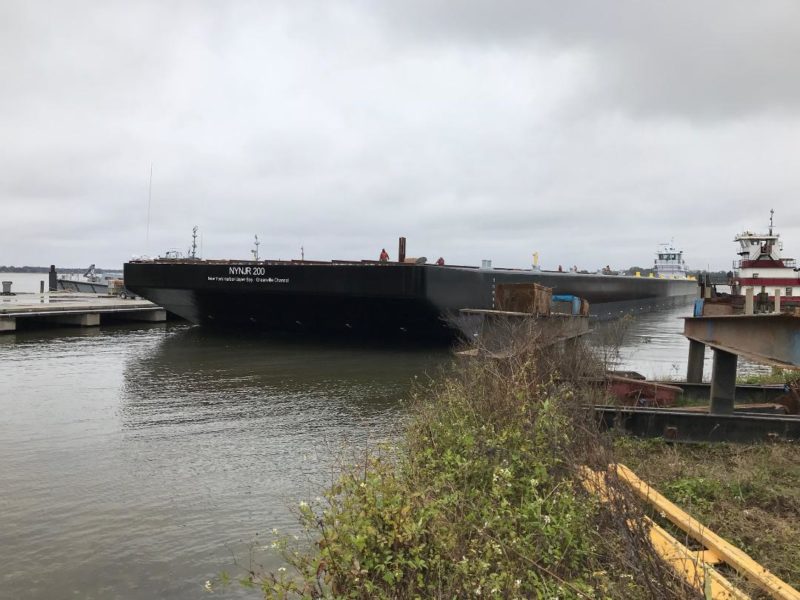Metal Trades Inc., Yonges Island, S.C., delivered the second in a pair of what are believed to be the first railroad car barges built for New York Harbor in perhaps 70 years.
The 370’x59’x14’ NYNJR200 carries up to 18 standard 60’ railcars for New York New Jersey Rail LLC, a short-haul railroad operated by the Port Authority of New York and New Jersey. The barge and sister ship NYNJR100 ferry cars between the Greenville Yard at Jersey City, N.J., and the 65th Street Yard in Brooklyn, N.Y.
Also known as carfloats, specialized rail barges were once common in New York Harbor, to help move freight between the Mid-Atlantic and New England states. The cross-harbor barging system, with its specialized landings, saved railroads time and money compared to shipping across crossings farther north up the Hudson River valley.

Rail barges crossing the Hudson River in 1936. New York State Archives.
The trade declined in the 20th century with competition from long-haul trucking. The Port Authority’s carfloat 278, which is still in service, “is estimated to have been built in the late 1940s or early 1950s for the Pennsylvania Railroad, so (it is) approximately 70 years old,” Port Authority officials said in response to a query from WorkBoat. “Unfortunately we have not been able to find the exact build date.”
The 278 carries up to 14 railcars, so the new barges with space for 18 per trip represent a 28.5% increase in capacity for the railroad. The cross-harbor moves happen eight to nine times per week on average.
There is significant seasonal variation in the service, according to the Port Authority. The first quarter of 2018 was especially rough with weather cancelling floats, while a milder December allowed 11 to 15 trips per week. By Dec. 20 the railroad had moved about 4,900 loaded railcars in 2018, for a total around 490,000 tons of cargo moved for the year.
That is “the equivalent of 20,000 to 25,000 heavy trucks removed from the region’s highways and roads in 2018,” note Port Authority officials, who are also promoting more use of container-on-barge services to reduce congestion and air pollution around the harbor.

A rail barge in operation at the New York New Jersey Rail yard in Jersey City, N.J. NYNJR photo.
Eastbound freight to Brooklyn is typically building materials such as lumber and cement powder, bulk food products like edible oils and flour, and bio-diesel fuel. Westbound floats carry loads of recycled commodities such as cullet (ground glass) and scrap steel. Loads were about evenly balanced between the New York and New Jersey sides in 2018 but the ratio can vary year to year.
For the railroad, the trend in carfloating is up. Traffic volume hit a low of 873 loaded railcars in 2009, the first full year when the Port Authority owned the NYNJR. Last year’s total of 4,900 loaded cars is up about 20% compared to 4,081 in 2017.




